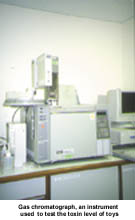Science |
Home | Archives | About | Media Links


October 1999
Children's
Gatekeeper -
Toy
Testing Story
By Wong Sze Man
See also: Q and A session......
As the living standard in Hong Kong is getting higher and higher, parents tend to buy more toys for their children.
However, the importance of choosing safe toys is sometimes neglected.
Fortunately, a group of chemists dealing with toys may give them a helping hand.
In the Smoking and Other Commodities Section of the Hong Kong Government Laboratory, the staffs are responsible for determining if toys contain excessive toxic substances.
"The main kinds of toxic substances we are testing can be divided into organic and inorganic ones," said Dr. Y.C. Yip, chemist of the Section.
"As for inorganic ones, we are referring to eight heavy metals, including antimony, arsenic, barium, cadmium, chromium, lead, mercury and selenium.
"On the other hand, dioctylphthalate is (an example of) what we mean by 'organic'."
The inorganic heavy metals are usually found in paints on toys, whereas the organic dioctylphthalate is found in plastics as "plasticisers", chemicals used in the manufacture of plastics to increase the softness and flexibility of plastics.
The concentration of dioctylphthalate is found by using a machine called a gas chromatograph. This analytical process is called gas chromatography.
Before carrying out the chromatography, the organic substance is extracted from the toy sample using an organic solvent.
According to Dr. Yip, the instrument allows automatic determination of dioctylphthalate's level.
What the staff chemist needs to do is to click on the keyboard, entering the sequence in picking up the sample bottles.
For testing inorganic elements, another machine, called an inductively-coupled plasma-atomic emission spectrometer, is employed.
To find out the concentration of the inorganic elements, paint flakes on the toy's surface are scrapped off for testing.
The spectrometer is used to determine the concentration of elements leached from the toy paint samples.
If children play with toxic toys, harmful substance may cause different adverse effects.
Dioctylphthalate, or the toxic organic substance, can cause dermatitis on long-term or repeated exposure.
Repeated or prolonged contact with arsenic and selenium will have the same consequence.
Arsenic and mercury are carcinogenic to human. Besides, antimony is found to cause lung and thorax tumors in some animal tests.
Skin sensitization may result if people are exposed to chromium for a long period of time.
Lead may cause retarded development of the newborn, whereas mercury can lead to cognitive disturbances and speech disorders.
Mercury can also affect human reproduction, according to animal tests.
Barium irritates the eyes, the skin, and the respiratory tract.
The safety standards used in toy testing follow any one of several international sets of standards, and the Smoking Products and Other Commodities Section performs the tests under the Toys and Children's Products Safety Ordinance.
Toys that comply with the requirements of any one of the standards are said to be "pass" in the tests.
Explained Dr. T.T. Kam, Senior Chemist of the Analytical and Advisory Services Division: "Merchants from nearly the whole world trade products in Hong Kong.
"As a result, we have to use three standards to determine whether or not a toy is safe to be used by consumers.
"We chose one standard from the United States and another one from Europe because they have high regards for toy safety requirements.
"However, we are planning to use a more harmonised international standard issued by International Standards Organization, or ISO, in future so as to avoid some minor differences among the three standards."
No matter which standard is adopted, toys violating the safety regulations will get into trouble.
The Commissioner of Customs and Excise will act on complaints and conduct spot checks under the Toys and Children's Products Safety Ordinance.
Toys about which there are complaints or those collected from spot checks will be sent to the Hong Kong Government Laboratory for safety tests.
For all prosecutions, test results of the laboratory will be used as evidence.
The Ordinance imposes a statutory duty on manufacturers, importers and suppliers of toys and children's products to ensure that the products they supply are safe.
Besides, they have to comply with the notices issued by the Commissioner of Customs and Excise.
A breach of the Ordinance may bring a fine of $100,000 and one year's imprisonment on first conviction.
On subsequent conviction, the fine will be $500,000 and the length of imprisonment will be two years.
Q: What is
gas chromatography?
A: Gas
chromatography is a chemical method that separates mixtures of
many compounds by passing them through a long capillary column
into their individual components. It is used in the
essential oil industry and in environmental monitoring.
Q: What is
atomic emission spectrometer?
A: It is an
instrument that excites the individual components of a sample by,
for example, heat and gives a graph known as emission spectrum
which points out the concentration of different components in the
sample.
Q: What are
the standards of toy testing?
A: They are:
1. International Voluntary Toy Safety Standard established by the
International Committee of Toy Industries.
2. European Standard EN71 established by the
European Committee for Standardization
3. ASTM F963, or Standard Consumer Safety Established by the
American Society for Testing and Materials
Home | Archives | About | Media Links